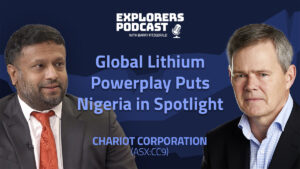The lithium sector’s second age is nearly here; these ASX stocks could open a gap on the pack

Pic: John W Banagan / Stone via Getty Images
The lithium sector has been on a tear in recent months with prices in China doubling since the beginning of 2021 while Australia’s Orocobre (ASX:ORE) and Galaxy Resources (ASX:GXY) are coming together in a $4bn merger to form the world’s fifth largest lithium chemicals company.
Benchmark Mineral Intelligence noted recently that prices of battery grade lithium carbonate had risen by 6 per cent in recent weeks to $US13,625 per tonne, or about 103.4 per cent year-to-date.
And It is projected to keep rising thanks to growing electric vehicle sales and low lithium supply availability.
Pilbara Minerals (ASX:PLS) has noted the improvements in spodumene concentrate prices highlighted “the recent strong upward trajectory in pricing” while Macquarie has flagged that lithium prices could increase by between 30 per cent and 100 per cent over the next four years as the sector moved into deficit.
Lithium sector: Go big or go extinct?
What this all mean for the multitude of lithium plays on the ASX and what is the next inflection point that investors should be looking out for?
Speaking to Stockhead, MineLife founding director Gavin Wendt drew parallels between the growing lithium sector and the iron ore sector about 20 years ago.
“In the 90s, China’s steel demand was starting to go through the roof and iron ore producers were struggling to keep up and we saw literally hundreds of new entities listing on the ASX and elsewhere that all had aspirations to get a slice of the pie,” he noted.
“There were a lot of companies out there exploring, a lot of them had MoUs or end users such as Chinese steel companies on their register.
“None of that means a lot if you don’t have a commercial product and can demonstrate that you can line it up.”
Wendt added that while there were many iron ore explorers at that time with the feeling that the industry would become more fragmented, that did not happen and most of the small plays have since disappeared.
“Maybe a dozen had gone into production and not all of those had been that successful in terms of making money,” he noted.
“The iron ore industry is more than ever dominated by the big players and if you look at the lithium industry at the moment, it’s also dominated by the big players.”
So just what’s the next inflection point that could separate the successful lithium plays from the has-beens?
Wendt believes that besides lithium prices consolidating gains, investors wanted to know how companies translated their significant market capitalisation gains into something sustainable.
“I think investors want to see companies that have identified resources and products that are marketable. They want to see end user agreements, offtake agreements, or memorandums of understanding.”
And even that might not be enough.
“Whilst it may be attractive from a market perspective to say that you have got an MoU with Volkswagen or Tesla or General Motors, I want to see what the terms are,” he added.
“Because at the present time the difficulty for a lot of emerging lithium companies is they’re going to be price takers as you’re talking about minnows in terms of market capitalisation on the supplier side dealing with multi-billion dollar end users who are in a significant position of strength when it comes to negotiations.”
Funding is also expected to be a difficulty for junior players with Wendt questioning their chance of success when competing against the likes of BHP and Rio.
“So far we have seen very few lithium projects that have been bank funded. The vast majority of them, have been funded by partners, usually an end user,” he said.
“If you’re a miner and you’re relying on an offtake agreement, the purchaser is in a position of strength. Ultimately it will depend on the pricing that they can secure.”
Vertical integration is the key
Wendt believes that one way for companies in the lithium sector to differentiate themselves is to follow Piedmont Lithium’s example and become more fully integrated.
“The benefit of moving up the food chain is the more value add that you can provide to your product from mine you know before it gets to the end user, the higher premium associated and that’s where the real value is,” he explained.
“And it also means that you’re not as vulnerable because the more basic your product is, the harder the negotiations the end users can enter into.
“I think I think the level of sophistication that will come into the lithium market will have parallels with iron ore where there was a higher level of expectation, but you really have to line up all your ducks in order to be successful.
ASX lithium sector plays
Here are some of the ASX lithium sector companies with news in the past month that may just have that X-factor that could see them through towards becoming producers.
Lithium hydroxide is the name of the game for Core Lithium (ASX:CXO), which has completed scoping level test work on samples sourced from its Finniss project to produce the battery grade chemical.
This lithium hydroxide has satisfied all impurity specifications and used the conventional ‘direct’ flowsheet with 95 per cent extract and recovery of lithium.
The project was also awarded Major Project Status by the Australian Government earlier this year.
Core has also started a major drilling program at Finniss.
European Lithium (ASX:EUR) holds the Wolfsberg lithium project about 270km south of Vienna Australia and has plans to produce lithium hydroxide to feed Europe’s growing appetite for battery metals as the shift towards electric vehicles continues.
A pre-feasibility study has already estimated that the project could produce 10,129tpa of lithium hydroxide in the accelerated case, delivering net present value – a measure of a project’s profitability – of $US339.4m (AUD$437.9m) based on the 10.98Mt resource.
There is also significant potential for growth given that the current resource is contained entirely within the project’s Zone 1 and previous drilling in the first quarter of 2018 on the other half of the project (Zone 2) returned positive results and could potentially double resources.
Its Phase 2 resource extension drilling program is currently underway with a second rig expected to begin operations at the beginning of May.
Meanwhile, Galan Lithium (ASX:GLN) is focused on its Hombre Muerto West project in Argentina where test work on the lithium brines project has resulted in the production of lithium chloride with a grade of 6 per cent lithium, or 32 per cent lithium carbonate equivalent.
This is directly comparable to the grade of output produced by SQM and Albemarle from the Atacama Basin in Chile and represents one of the highest publicly known brine concentrate grades delivered by evaporation in the world.
Galan plans to begin commissioning evaporation pilot test work onsite during the second quarter of 2021 that will test the conversion of lithium chloride to battery grade lithium carbonate.
The company has also completed a review of historical data that has enhanced the prospectivity of its 43sqkm Greenbushes South lithium project in Western Australia.
Also pursuing the goal of producing lithium chemicals is Hawkstone Mining (ASX:HWK), which has produced battery grade lithium carbonate during initial metallurgical testing of sedimentary material from its Big Sandy project in Arizona.
Full-scale bench-scale testing and design of a continuous-operation pilot plant has started and a permit to carry out further exploration drilling is expected to be received soon.
The project also benefits from its location near the heart of North America’s battery corridor.
Next up on the list of lithium sector companies is Jindalee Resources (ASX:JRL), which has one of the largest lithium deposits in the US with an inferred and indicated resource of 10.1 million tonnes of lithium carbonate equivalent contained within the McDermitt project in Oregon.
Despite this, there’s plenty of room to grow with the company estimating an exploration target of between 1.3 billion to 2.3 billion tonnes at 1,100 parts per million to 1,500ppm lithium.
Prospect Resources (ASX:PSC) recently noted that it has completed about 70 per cent of the engineering, procurement and construction scope for its high purity petalite pilot plant.
The pilot plant remains on schedule and on budget with first shipment of petalite – a lithium mineral – by the end of the second quarter using feed from its Arcadia project in Zimbabwe.
A definitive feasibility study has estimated that the project could generate pre-tax NPV of $US710m with average annual earnings before interest, taxes, depreciation, and amortisation of $US168m for the first five years of operation.
Over in Germany, Vulcan Energy Resources (ASX:VUL) has started the pilot lithium extraction plant at its Zero Carbon Lithium project in Germany’s Upper Rhine Valley.
The pilot plant is aimed at demonstrating direct lithium extraction (DLE) from live geothermal brine produced from existing wells with work focused on demonstrating pre-treatment and DLE processes.
Data from the plant will be used to finalise the design of a larger demonstration plant that will contribute to the DFS.
ASX Lithium companies
| Code | Company | Price | %Mth | %SixMth | %Wk | %Yr | MktCap |
|---|---|---|---|---|---|---|---|
| VUL | Vulcan Energy | 7.96 | 35 | 527 | -4 | 3602 | $ 855,415,477.76 |
| RLC | Reedy Lagoon Corp. | 0.02 | -17 | 100 | -5 | 900 | $ 9,400,523.32 |
| PLLDA | Piedmont Lithium Inc | 0.895 | 3 | 167 | -9 | 795 | $ 1,409,575,327.50 |
| QPM | Queensland Pacific | 0.11 | 28 | 233 | -19 | 746 | $ 130,124,233.25 |
| JRL | Jindalee Resources | 2.56 | 39 | 232 | -12 | 713 | $ 136,714,152.96 |
| LKE | Lake Resources | 0.27 | -19 | 358 | -18 | 630 | $ 275,904,477.72 |
| EMH | European Metals Hldg | 1.45 | -4 | 163 | 7 | 623 | $ 187,295,069.43 |
| PLS | Pilbara Min Ltd | 1.18 | 7 | 188 | -1 | 518 | $ 3,418,336,845.76 |
| CXO | Core Lithium | 0.255 | 13 | 431 | -11 | 493 | $ 299,399,899.77 |
| GXY | Galaxy Resources | 4.11 | 48 | 186 | 3 | 477 | $ 2,077,074,481.20 |
| FFX | Firefinch Ltd | 0.355 | 54 | 118 | -1 | 446 | $ 277,996,594.65 |
| SYA | Sayona Mining Ltd | 0.037 | 3 | 376 | -3 | 444 | $ 165,741,126.30 |
| INF | Infinity Lithium | 0.19 | -3 | 113 | 0 | 414 | $ 76,504,365.64 |
| GLN | Galan Lithium Ltd | 0.73 | 16 | 508 | -12 | 387 | $ 175,605,851.53 |
| ASN | Anson Resources Ltd | 0.069 | -13 | 103 | -7 | 306 | $ 61,683,077.30 |
| TKL | Traka Resources | 0.016 | -6 | -27 | -6 | 303 | $ 8,103,441.09 |
| LTR | Liontown Resources | 0.41 | -9 | 82 | 3 | 242 | $ 743,890,710.67 |
| ORE | Orocobre Limited | 7.09 | 42 | 165 | 3 | 233 | $ 2,440,080,730.48 |
| INR | Ioneer Ltd | 0.375 | -3 | 92 | -10 | 213 | $ 711,159,443.63 |
| MIN | Mineral Resources. | 47.57 | 20 | 81 | 0 | 187 | $ 8,978,170,663.74 |
| ADV | Ardiden Ltd | 0.011 | -35 | -66 | -15 | 175 | $ 23,642,896.38 |
| LPD | Lepidico Ltd | 0.017 | -23 | 113 | -11 | 143 | $ 88,193,953.39 |
| LIT | Lithium Australia NL | 0.12 | 9 | 140 | -4 | 140 | $ 108,227,973.24 |
| AVZ | AVZ Minerals Ltd | 0.15 | -19 | 100 | -17 | 127 | $ 433,524,776.25 |
| LPI | Lithium Pwr Int Ltd | 0.29 | 9 | 41 | 2 | 115 | $ 87,312,486.31 |
| MLS | Metals Australia | 0.002 | -20 | 0 | 0 | 100 | $ 8,454,376.09 |
| AGY | Argosy Minerals Ltd | 0.087 | -1 | 78 | -6 | 98 | $ 108,773,638.25 |
| AJM | Altura Mining Ltd | 0.07 | 0 | 0 | 0 | 84 | $ 209,037,029.25 |
| PSC | Prospect Res Ltd | 0.16 | -22 | 60 | 14 | 78 | $ 59,740,910.88 |
| TNG | TNG Limited | 0.091 | -17 | -13 | -5 | 54 | $ 113,704,230.64 |
| TON | Triton Min Ltd | 0.044 | 2 | -6 | 7 | 26 | $ 49,916,594.95 |
| EUR | European Lithium Ltd | 0.056 | -10 | 44 | -13 | 24 | $ 51,927,060.53 |
| GL1 | Global Lithium (listed May 6) | 0.28 | 40 | $ 24,913,250.88 | |||
| ESS | Essential Metals Ltd | 0.096 | -13 | 2 | 1 | -20 | $ 19,278,460.80 |
| AML | Aeon Metals Ltd. | 0.072 | -20 | -47 | -4 | -23 | $ 48,785,020.34 |
Related Topics
UNLOCK INSIGHTS
Discover the untold stories of emerging ASX stocks.
Daily news and expert analysis, it's free to subscribe.
By proceeding, you confirm you understand that we handle personal information in accordance with our Privacy Policy.








